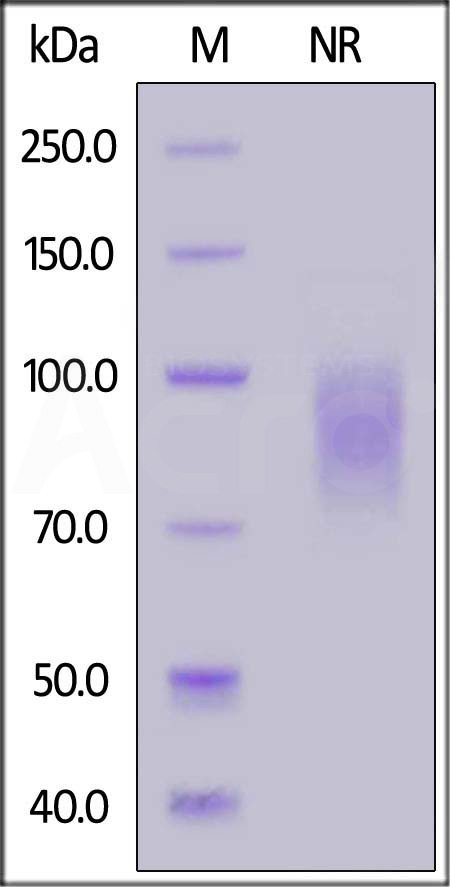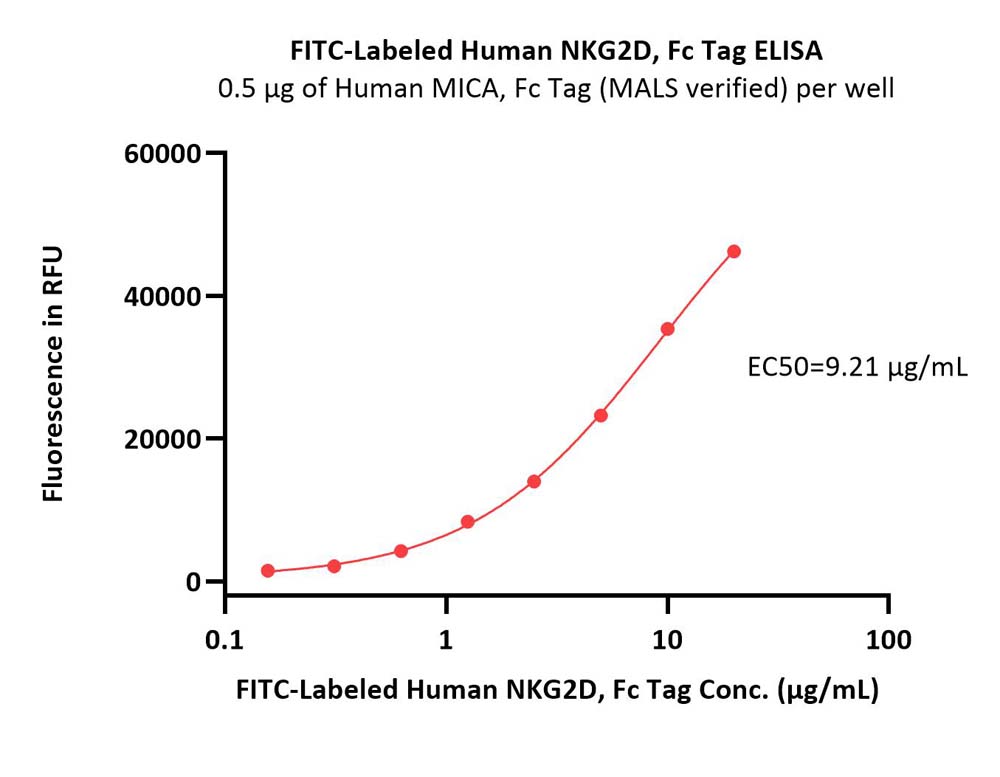分子别名(Synonym)
NKG2D,CD314,KLRK1,NK cell receptor D
表达区间及表达系统(Source)
FITC-Labeled Human NKG2D, Fc Tag (NKD-HF224) is expressed from human 293 cells (HEK293). It contains AA Ile 73 - Val 216 (Accession # P26718-1).
Predicted N-terminus: Pro
Request for sequence
蛋白结构(Molecular Characterization)

This protein carries a human IgG1 Fc tag at the N-terminus.
The protein has a calculated MW of 43.1 kDa. The protein migrates as 75-110 kDa when calibrated against Star Ribbon Pre-stained Protein Marker under non-reducing (NR) condition (SDS-PAGE) due to glycosylation.
偶联(Conjugate)
FITC
Excitation source: 488 nm spectral line, argon-ion laser
Excitation Wavelength: 488 nm
Emission Wavelength: 535 nm
标记(Labeling)
The primary amines in the side chains of lysine residues and the N-terminus of the protein are conjugated with FITC using standard chemical labeling method. The residual FITC is removed by molecular sieve treatment during purification process.
蛋白标记度(Protein Ratio)
The FITC to protein molar ratio is 1.5-3.5.
内毒素(Endotoxin)
Less than 1.0 EU per μg by the LAL method.
纯度(Purity)
>90% as determined by SDS-PAGE.
制剂(Formulation)
Lyophilized from 0.22 μm filtered solution in PBS, pH7.4 with trehalose as protectant.
Contact us for customized product form or formulation.
重构方法(Reconstitution)
Please see Certificate of Analysis for specific instructions.
For best performance, we strongly recommend you to follow the reconstitution protocol provided in the CoA.
存储(Storage)
For long term storage, the product should be stored at lyophilized state at -20°C or lower.
Please protect from light and avoid repeated freeze-thaw cycles.
This product is stable after storage at:
- -20°C to -70°C for 12 months in lyophilized state;
- -70°C for 3 months under sterile conditions after reconstitution.
质量管理控制体系(QMS)
电泳(SDS-PAGE)

FITC-Labeled Human NKG2D, Fc Tag on SDS-PAGE under non-reducing (NR) condition. The gel was stained with Coomassie Blue. The purity of the protein is greater than 90% (With Star Ribbon Pre-stained Protein Marker).
活性(Bioactivity)-ELISA

Immobilized Human MICA, Fc Tag (MALS verified) (Cat. No. MIA-H5253) at 5 μg/mL (100 μL/well) can bind FITC-Labeled Human NKG2D, Fc Tag (Cat. No. NKD-HF224) with a linear range of 0.156-10 μg/mL (QC tested).
Protocol
背景(Background)
NKG2D is a transmembrane protein belonging to the CD94/NKG2 family of C-type lectin-like receptors, also known as KLRK1, CD314, D12S2489E, KLR and killer cell lectin like receptor K1. NKG2D itself forms a homodimer whose ectodomains serve for ligand binding. NKG2D is a major recognition receptor for the detection and elimination of transformed and infected cells as its ligands are induced during cellular stress, either as a result of infection or genomic stress such as in cancer. In NK cells, NKG2D serves as an activating receptor, which itself is able to trigger cytotoxicity. The function of NKG2D on CD8+ T cells is to send co-stimulatory signals to activate them.























































 膜杰作
膜杰作 Star Staining
Star Staining
















